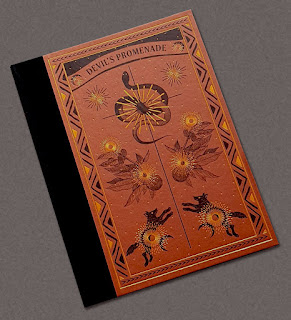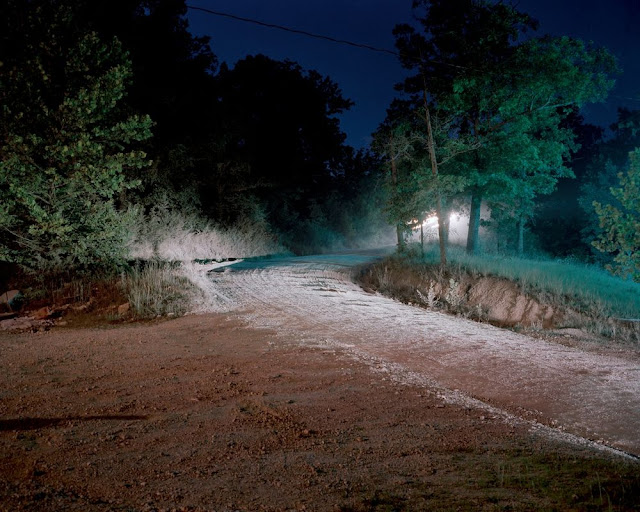 |
Devil’s Promenade. By Antone Dolezal & Lara Shipley.
|
Photographs by Antone Dolezal & Lara Shipley
Overlapse, 2021. 152 pp., 104 illustrations, 6¾x9".
Within the American Breadbasket exists a physiographic region called The Ozarks. Locals will tell you that within these mountains, covering sections of Oklahoma, Kansas, Arkansas and Missouri, resides the Devil. It is within the Ozarks, on a wooded gravel road, known affectionately and sinisterly as the Devil’s Promenade, that evil lurks. For decades this evil has revealed itself as a floating orb, also known as the Ozark Light or ‘spooklight’.
Shipley and Dolezal tackle the folklore at the heart of this project in a fashion similar to Maria Lax’s Some Kind of Heavenly Fire, Amani Willett’s The Disappearance of Joseph Plummer, or Maja Daniels’ Elf Dalia, by applying mixed media to a form of elevated and layered storytelling.
 |
The archival images — those blurry frames of old faces — blend well with the crisp images Shipley and Dolezal produce; a delicate dance that unfolds throughout the book. The skulls and snakes, they make sense, but some portraits at first allude… who are these faces past and present, and what is their bearing on this place, its dark undertones and these balls of light? But we must remember that there is no story of place without people. Well disguised, this is a book about the region, a narrative of rural America, told through folklore acting as a welcomed break from the plight-heavy approach of nearly all contemporary narratives on the subject.
My visual vocabulary of the Ozarks is scant, as a result, I borrow tropes from the American South — the mysticism and religious overtones that a thick brush can conjure. This isn’t much of a stretch, the European folklore that fuelled the idea of myth in Southern Appalachia has found its way to this region. Both Appalachia and the Ozarks are old frontier territories, partly enclosed and remote. Both have largely retained their bubble of wooded frontierism.
Some photobooks leave you with an idea (a rumination), others an emotion (a pathos). The best books do both. Devil’s Promenade does both. I feel structure. I feel dead eyes. I feel the wilderness swimming around my legs and towering Bois D’arc trees swaying overhead. The Ozarks are in the Mid-West, but you don’t feel it. This is something different. Elements of the occult linger and something feels off about the place.
 |
Devil’s Promenade speaks to an innate familiarity with the region, an emotive intrigue that also feels restrained and distanced. Like an old friend who you’ve left behind as you’ve grown, memory and fondness linger, but at the core… things have changed… you have changed. We glimpse this feeling in the portraits. They speak of a familiarity only the native sons and daughters of a region know, however, they are the derivative of closeness, they lack warmth. Intrigue is also present, a reverence for a place and time no longer wholly understood — the common outcome for those who leave and return.
The Ozarks are a hilled region, old mountains that have been ground down, offering little to the farmer, a blight on the boastful soils of America’s Breadbasket in which they firmly sit. This is a poor land for farmers, a poor land where a spectre haunts.
The orb is a hook. It is a distraction placed before us so that we may gaze upon the Ozarks and learn its unique folklore, identity, history, and struggles. The orb is intrigue, and it is metaphor. The orb is a proxy for the devil and aged fables about the devil lurking in the wild. The beast we should worry about is the one inside of us. As Lara Shipley writes, “we try to put the Devil in the woods to remove him from our bodies”.
How we interpret the orb depends on how we invite the idea of good and evil in. There are many ways to save a soul, you can bathe it in baptismal waters, you can suck out evil with a palm to one’s forehead and maybe, with the right intentions, you can gaze upon an orb on the Devil’s Promenade and feel cleansed. I also wonder, if we stopped talking about the orbs, stopped searching them out, would they disappear?
Purchase Book
Read More Book Reviews
 |
 |
Kyler Zeleny (1988) is a Canadian photographer, educator and author of Out West (2014), Found Polaroids (2017), and Crown Ditch & The Prairie Castle (2020). He holds a masters from Goldsmiths College, in Photography and Urban Cultures and a PhD from the joint Communication & Culture program at Ryerson and York University. His work has been exhibited internationally in twelve countries and has been featured in numerous publications including The Globe & Mail, Vice, The Washington Post, The Guardian, and The Independent. He occupies his time by exploring photography on the Canadian prairies.











